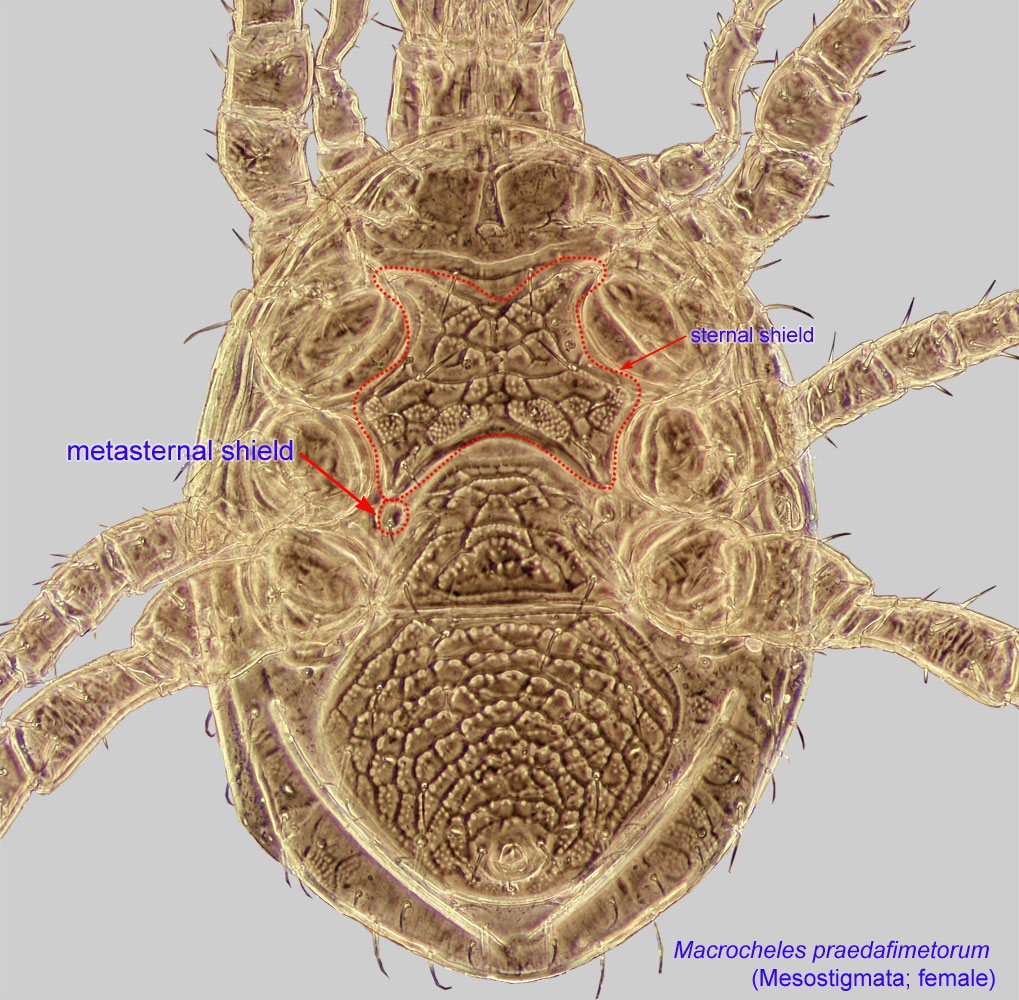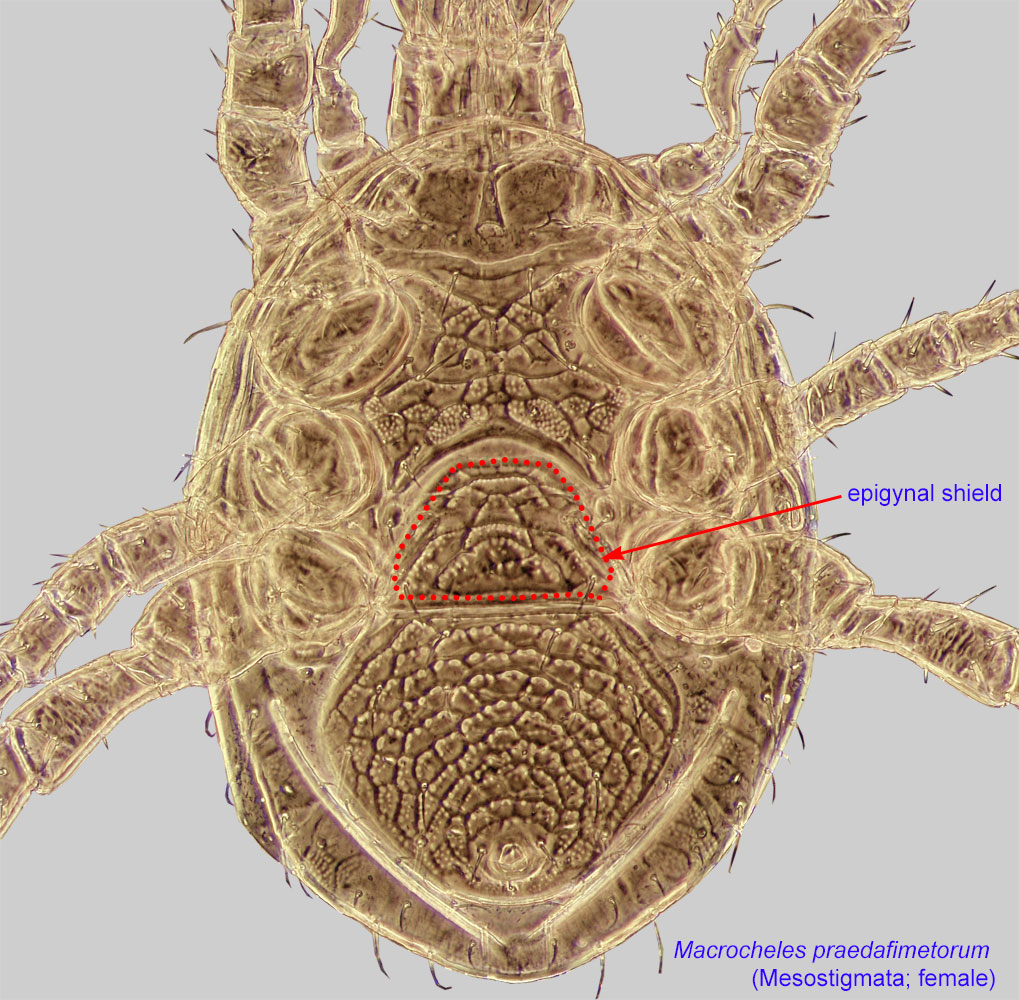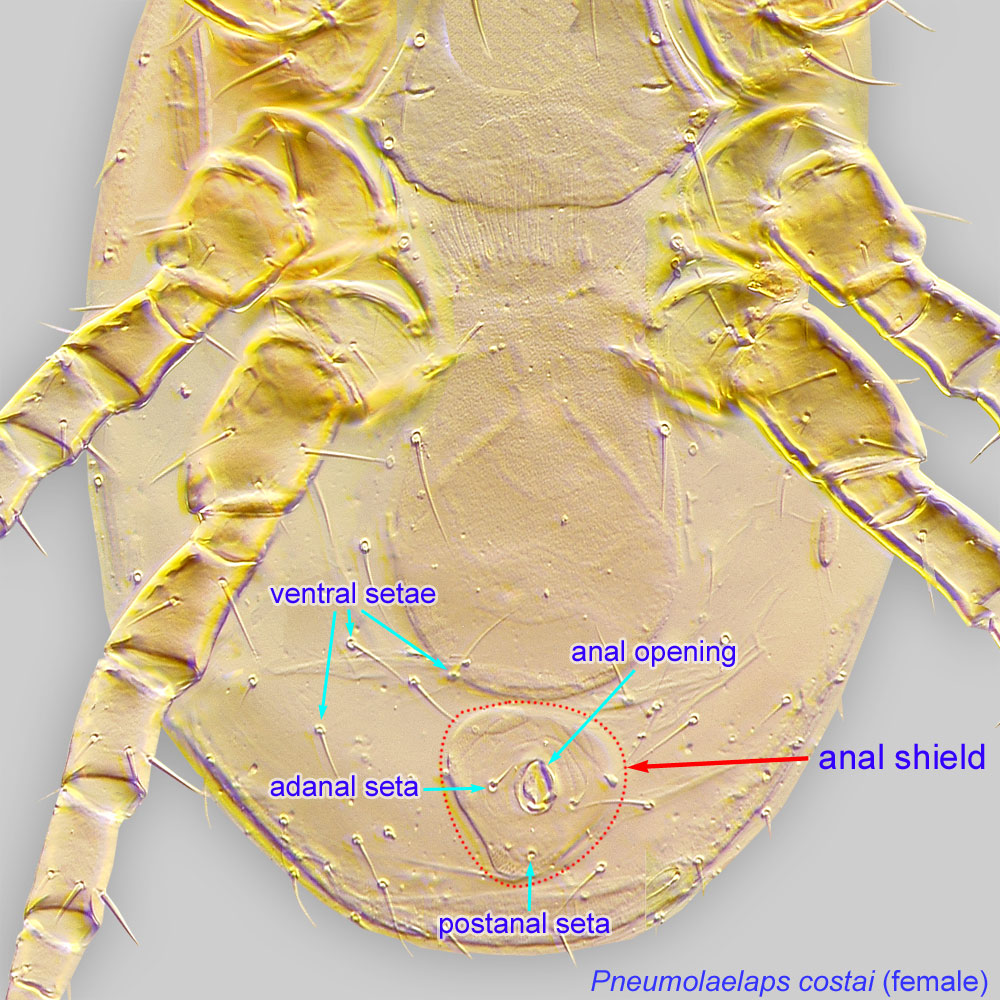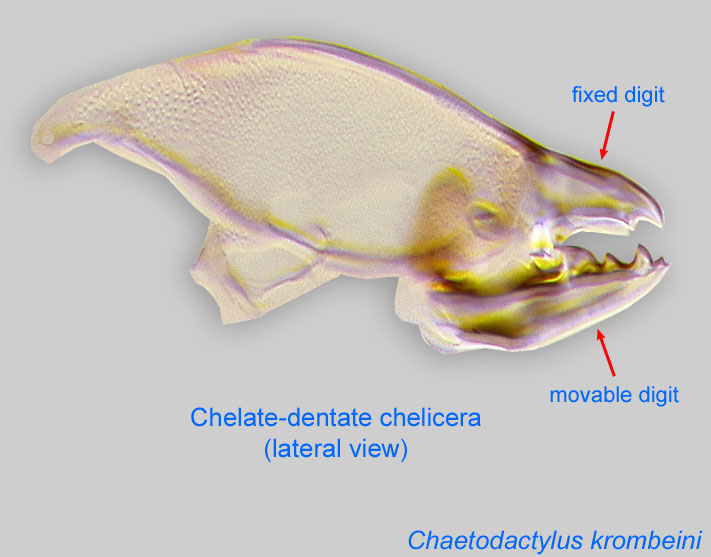generalist species may be harmful, feeding on eggs, larvae, and pupae; bee specialist species' feeding habits unknown
Proctolaelaps Berlese, 1923
Superorder Parasitiformes » Order Mesostigmata » Suborder Monogynaspida » Hyporder Dermanyssiae » Family Melicharidae » Genus Proctolaelaps
Proctolaelaps productus Berlese, 1923
Garmaniella Westerboer, 1963
Adult: Dorsal shield entire (Figs. 1, 3); setae z3 present (Fig. 3). Most setae in R-series situated on dorsal shield (Fig. 3) and not on unsclerotized cuticle.
Female: Fixed cheliceral digit with pilus dentilispilus dentilis:
A seta-like or membranous sensory organ inserted ventrolaterally on the fixed digit of the chelicera of many Mesostigmata.
modified to a membranous lobe (Figs. 11, 12, 13). Movable cheliceral digit with a pointed process (mucro) on its mid-ventral face; in bumble bee associated mites mucro situated on external side of movable digit (Fig. 12). Peritrematic shield of adults free posteriorly from exopodal plate IV (Fig. 8). Metasternal shieldsMetasternal shield:
Small, usually teardrop to subtriangular paired shields bearing metasternal setae st4; sometimes fused to the sternal shield or the endopodal shields. Present in Mesostigmata.
 present (Figs. 4, 6). Epigynal shieldepigynal shield:
present (Figs. 4, 6). Epigynal shieldepigynal shield:
A shield protecting the female genital opening. Well-developed in Mesostigmata. Also known as epigynial shield.
 gently rounded posteriorly (Figs. 5, 6). Anal shieldanal shield:
gently rounded posteriorly (Figs. 5, 6). Anal shieldanal shield:
In Mesostigmata, a ventral shield bearing the anal opening and circumanal setae (adanal or postanal setae), but without any ventral setae or pores (lyrifissures) on it. If ventral setae are present on shield than referred to as a ventrianal shield.
 oval or elliptical, bearing only the 3 anal setae (Fig. 7) (some taxa may have opisthogastric setae on anal shieldanal shield:
oval or elliptical, bearing only the 3 anal setae (Fig. 7) (some taxa may have opisthogastric setae on anal shieldanal shield:
In Mesostigmata, a ventral shield bearing the anal opening and circumanal setae (adanal or postanal setae), but without any ventral setae or pores (lyrifissures) on it. If ventral setae are present on shield than referred to as a ventrianal shield.
 ).
).
A dichotomous key is not available for all species. The most recent key can be found in Karg, 1988Karg, 1988:
Karg, W. 1988. Zur Kenntnis der Gattung Proctolaelaps Berlese, 1923 (Acarina, Parasitiformes). Zoologische Jahrbuecher Abteilung fuer Systematik Oekologie und Geographie der Tiere.115: 441-454.. A key to species associated with bumble bees in North America is available from the bee-associated mites website.
Cosmopolitan. Species permanently associated with bumble bees have been recorded in the Palaearctic and Neotropical regions. Many species in this group have broad, intercontinental distributions.
bumble bees (Bombus) and honey bees (Apis)
facultative facultative:
can complete entire life cycle without bees or their close relative, wasps
(generalist species) or permanentpermanent:
associated exclusively with bees or their close relative, wasps; cannot live without these hosts
(bumble bee-associated species)
Generalist species (e.g., Proctolaelaps pygmaeus and P. bickleyi)
Bumble bee-specialist species (Proctolaelaps bombophilus, P. longanalis, P. longisetosus, P. ornatus, and P. sibiriensis)
This genus includes nearly 100 species with diverse ecologies. They are common inhabitants in beetle galleries, ant colonies, bumble bee nests, stored products, insect cultures, rotting fruit, flowers, and soil.
Among Proctolaelaps, there is a group of species recorded only from bumble bee nests (Proctolaelaps bombophilus, P. longanalis, P. longisetosus, P. ornatus, and P. sibiriensis). In contrast to most generalist species of Proctolaelaps with multidentate fixed chelicerate digits, the bumble bee species display fixed chelicerate digits with just a few teeth, and they lack the typical ventral process (mucro) on the movable digit. The disparity in cheliceral morphology may suggest a different type of and/or more specialized feeding.
Other species associated with bees include habitat generalists Proctolaelaps pygmaeus found in nests of bumble bees and honey bees and Proctolaelaps bickleyi found, among other habitats, in honey bee hives. In addition, one species, Proctolaelaps scolyti, normally associated with bark beetles, has been recorded from Apis mellifera.
Proctolaelaps pygmaeus is an example of a cosmopolitan habitat generalist that can be found in soil, decomposing plant material, bulbs, moss, stored food, under bark, and nests of small mammals, bumble bees, and honey bees. This species may be predatory on small arthropods, but is also a fungivore, and unlike most similar mites, it is able to ingest solid matter (fungal conidia, arthrospores, hyphae, or yeast). There is circumstantial evidence that it can attack humans and that the results can be severe enough to cause extensive papular dermatosis (reviewed by Halliday, 1997Halliday, 1997:
Halliday, R. B. 1997. Revision of the Australian Ameroseiidae (Acarina: Mesostigmata). Invertebrate Taxonomy.11: 179-201.). Feeding on both animal prey (small mites) and fungi has been confirmed in laboratory experiments for Proctolaelaps bulbosus (Galvao et al., 2011Galvao et al., 2011:
Galvao, A. S., M. G. C. Gondim Jr amp; G. J. Moraes. 2011. Life history of Proctolaelaps bulbosus feeding on the coconut mite Aceria guerreronis and other possible food types occurring on coconut fruits. Experimental and Applied Acarology.53: 245-252.). Proctolaelaps regalis, which is normally an omnivore species that feeds on fungi and microarthropods, could also prey on eggs, larvae, and pupae of Drosophila by rapid cheliceral thrusting (Houck et al., 1991Houck et al., 1991:
Houck, M. A., J. B. Clark, K. R. Peterson amp; M. G. Kidwell. 1991. Possible horizontal transfer of Drosophila genes by the mite Proctolaelaps regalis . Science (Washington D C). 253: 1125-1129.).
Other species are more specialized. For example, feeding on nectar of tropical flowers and dispersing on hummingbirds, butterflies, or honey possums has been seen (Dusbabek et al., 2007Dusbabek et al., 2007:
Dusbabek, F., I. Literak, M. Capek amp; M. Havlicek. 2007. Ascid mites (Acari: Mesostigmata: Ascidae) from Costa Rican hummingbirds (Aves: Trochilidae), with description of three new species and a key to the Proctolaelaps belemensis species group. Zootaxa. 1484: 51-67.; Guerra et al., 2010Guerra et al., 2010:
Guerra, T. J., G. Q. Romero amp; W. W. Benson. 2010. Flower mites decrease nectar availability in the rain-forest bromeliad Neoregelia johannis. Journal of Tropical Ecology.26: 373-379.). Proctolaelaps nauphoetae is a true parasite of the cockroach Nauphoeta cinerea (Blattidae); it inserts its cheliceraechelicera:
Anterior, paired appendage of the body. Primary organ for food acquisition, adapted for chewing, piercing, tearing, sucking, or filtering.
 through the cuticle of its host and feeds on the hemolymph.
through the cuticle of its host and feeds on the hemolymph.